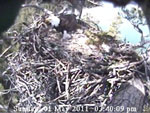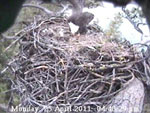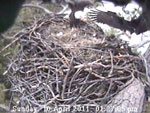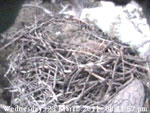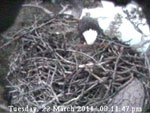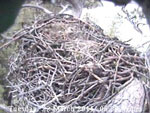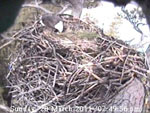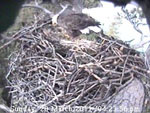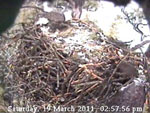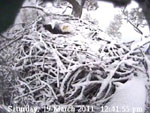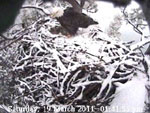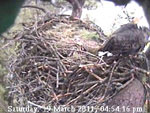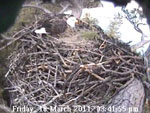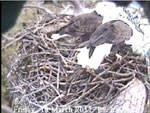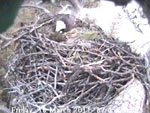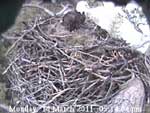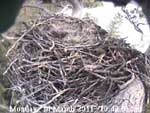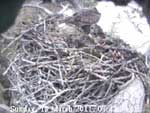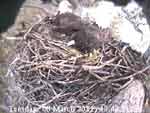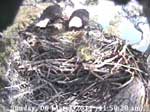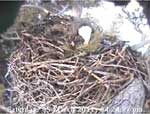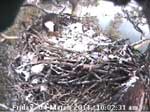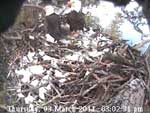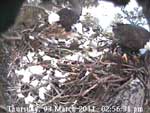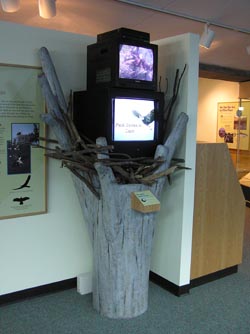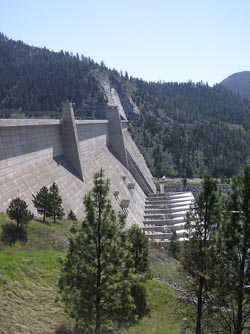CURRENT IMAGE
Image updates
approx. every 2 minutes. Do a Shift or CTRL Refresh for most
current view.
YouTube video of laying of 1st egg, March 18, 2011:
http://www.youtube.com/watch?v=0hDjpZOtziQ
Click here for more 2011 nesting season highlights

Pictures below are from last 24 hours:
(Click thumbnails for bigger picture)
Click here for recent highlights
8 am |
9 am |
10 am |
|||
2 pm |
3 pm |
4 pm |
|||
5 pm |
6 pm |
8 pm
|
9 pm
|
10 pm
|
2011 nesting season highlights: YouTube video of nesting activity from March 1-5, 2011:http://www.youtube.com/watch?v=XyCcdyMhkS4 Nest-tending.... March 6, 2011 YouTube video of laying of 1st egg, March 18, 2011: http://www.youtube.com/watch?v=0hDjpZOtziQ Nesting Season Overview: Nest tending activity usually starts in January and February, depending on the weather. Snowstorms tend to delay the nest tending and repair activity. The first eggs usually are observed in the nest about mid-March, often followed by a second egg within a couple days. The eagles sit on the eggs almost constantly until they hatch about a month later. The eaglets spend about two months growing before they are big and strong enough to fly. The young typically fledge (leave) the nest around the end of July. Bald eagles are believed to mate for life and can live up to 25 years. Both adults take turns tending the nest. Libby Dam Eagle Cam: The Libby Dam eagle cam is located near Souse Gulch on the Kootenai River. This nest began in 1996 and has been active annually. This image is updated every 2 minutes. (You may need to refresh your browser page to view the latest image). Scroll down this page for technical information about the camera set up. Look at the column to the right for historical information about the nest, eaglets and how many fledglings since 1996. In general, the nest becomes active in March and eaglets fledge in late July or early August. A breeding adult pair produces 1-2 young eaglets each year. To see the current image from the Libby Dam Eagle Cam, which updates every 10 seconds, click on this link: |
Camera Equipment: Camera Setup: The enclosure is attached to the branch with lag bolts and is approximately 100' above the ground. The camera and heater run on 24 volts ac. There is a 120:24 volt transformer in the enclosure in which 120 vac supplies the equipment. One power and one signal (coax) cable go down the tree to the ground. From there they go 600' underground to the Libby Dam weather station which overlooks Lake Koocanusa. At the weather station the eaglecam picture signal goes to a microwave transmitter and is transmitted about a mile, at a baud rate of 115,200 kbps, to a receiver on top of the Libby Dam Visitor Center. From that receiver a coax cable goes down into the Visitor Center ceiling. In the Visitor Center ceiling the signal is split two ways. One goes to a monitor in the Visitor Center display area where the public can view the live broadcast on a television monitor. The other way goes to the Visitor Center basement where there is a computer that broadcast it over the local area network and to the internet. More technicall details from the U.S. Army Corps of Engineers: Eagle Cam Camera setup More info: |
Nest History:
2011:
May 1: 2 Chicks observed in nest
Apr. 25: Chick observed in nest
Mar. 20: 2nd egg observed in nest
Mar. 18: 1st egg in nest
Mar. 3: Webcam and radio repaired, replaced and operational.
A pair of eagles observed in nest this afternoon.
Feb. 28: No nesting activity observed to date. Recent
snowstorms may have delayed activity.
2010:
April 22: Still 2 eggs in the nest
March 22: 2nd egg spotted in nest
March 19: 1 egg in nest
February/March 18: Nest tending...
February 24: Adult eagle observed on nest.
View pictures
2009:
July ??: Chick expected to fledge the nest
and go out on its own
May 16: One of the chicks died from unknown
causes.
April 24: 2 eaglets observed in nest.
March 25: 2 eggs observed in snowy nest.
March 18: 1 egg observed in nest.
March 17: Eagle appears to be sitting on an
egg. Weather is cold and snowy.
March 16: Adults have been tending nest and adding
branches and moss for several weeks.
View pictures
2008:
July 27: Chicks flying in and out of nest
May 5: 2 chicks in nest
March 24: 2nd egg observed in nest
March 19: 1 egg observed in nest
2007:
April 30: 2 eaglets in nest
July 13: 2 fledged,
2006::
March 27, 2006:
2 eaglets in nest
0 fledged
2005:
July 20, 2005:
1 eaglet fledged
March 27, 2005:
One of the eaglets died from unknown
causes.*
March 22, 2005:
2 eaglets in nest
2004:
July 23, 2004:
1 eaglet fledged
March 31, 2004:
2 eaglets in nest
2003:
August 2, 2003:
1
eaglet fledged
April 21, 2003:
1 eaglet in nest
2002:
July 11, 2002:
2 eaglets fledged
March 12, 2002:
2 eaglets in nest
2001:
July 18, 2001:
2 eaglets fledged
March 21, 2001:
2 eaglets in nest
2000:
July 16, 2000:
2 eaglets fledged
March 21, 2000:
2 eaglets in nest
1999:
July 11, 1999:
2 eaglets fledged
March 21, 1999:
2 eaglets in nest
1998:
July 27, 1998:
2 eaglets fledged
April 18, 1998:
2 eaglets in nest
1997:
July 14, 1997:
2 eaglets fledged
April 3 , 1997:
2 eaglets in nest
1996:
June 23, 1996:
Nest started
*Note: It is not uncommon for eaglets to die in the early stages of development. Death may occur from natural causes, predators, competition for food, or even Fratricide (killing of one's sibling).
Nest History
Bald Eagle Facts
(Libby Dam pages)
Libby
Dam Project
Libby
Dam Visitor Center
Kootenai
River Drainage
Kootenai
River Flows







